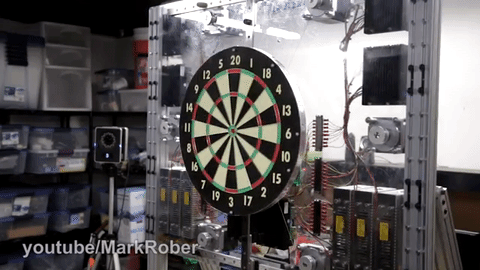Darts: always a bullseye!

Darts is definitely much harder than it looks – perhaps it has something to do with that fact that this game is often played in bars and the accuracy tends to be inversely proportional to the beer consumption...
Darts is definitely much harder than it looks – perhaps it has something to do with that fact that this game is often played in bars and the accuracy tends to be inversely proportional to the beer consumption...
To hit the bullseye (which is significantly more difficult than hitting the board just anywhere) requires practice, a lot of practice. Something that former NASA engineer Mark Rober (these days a popular YouTuber) didn't have much interest in.
The board is then moved at high speed, using six stepper motors and a bit of trigonometry, to the correct spot to catch the dart exactly in the bullseye. The prediction of the position of the impact is constantly updated and the position of the board corrected accordingly, if necessary.
A sourpuss will probably remark that the joy of this game is now pretty much gone – but that is more than compensated for by the pleasure of designing and building of such a delightful, pointless, high-tech system…
To hit the bullseye (which is significantly more difficult than hitting the board just anywhere) requires practice, a lot of practice. Something that former NASA engineer Mark Rober (these days a popular YouTuber) didn't have much interest in.
Half a second
He therefore sat down at his drawing board and designed a system that determines exactly where a dart is, calculates at lightning speed where it will land, and then moves the dart board in such a way that the dart will land exactly in the bullseye. And all this in less than half a second: a typical dart throw lasts about 400 ms (measured over the 'official' match distance). In other words: if the dart won't come to the bullseye, then the bullseye must go to the dart...Motion capture
The heart of the system that Mark Rober developed over a period of three years (!), is formed by a Vicom motion capture system with six cameras, that tracks a dart during its flight through the air; this is done with IR LEDs and small retro-reflectors on the dart. A computer system then calculates the exact location in three-dimensional space from all this. As an aside: these motion-capture systems became really well-known through Andy Serkis in his role as Gollum.Servo system
From the sequence of positions of the dart (the system succeeds in determining these more than 100 times during the not even half-second that the dart is in the air), the software calculates, with the aid of some elementary physics, where the dart will hit on the two-dimensional surface that is within the area that the dart board can move to.The board is then moved at high speed, using six stepper motors and a bit of trigonometry, to the correct spot to catch the dart exactly in the bullseye. The prediction of the position of the impact is constantly updated and the position of the board corrected accordingly, if necessary.
A sourpuss will probably remark that the joy of this game is now pretty much gone – but that is more than compensated for by the pleasure of designing and building of such a delightful, pointless, high-tech system…

